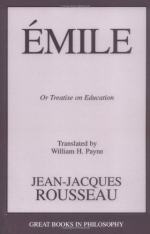I see some one giving an ice-cream to an eight-year-old child; he does not know what it is and puts the spoon in his mouth. Struck by the cold he cries out, “Oh, it burns!” He feels a very keen sensation, and the heat of the fire is the keenest sensation he knows, so he thinks that is what he feels. Yet he is mistaken; cold hurts, but it does not burn; and these two sensations are different, for persons with more experience do not confuse them. So it is not the sensation that is wrong, but the judgment formed with regard to it.
It is just the same with those who see a mirror or some optical instrument for the first time, or enter a deep cellar in the depths of winter or at midsummer, or dip a very hot or cold hand into tepid water, or roll a little ball between two crossed fingers. If they are content to say what they really feel, their judgment, being purely passive, cannot go wrong; but when they judge according to appearances, their judgment is active; it compares and establishes by induction relations which are not really perceived. Then these inductions may or may not be mistaken. Experience is required to correct or prevent error.
Show your pupil the clouds at night passing between himself and the moon; he will think the moon is moving in the opposite direction and that the clouds are stationary. He will think this through a hasty induction, because he generally sees small objects moving and larger ones at rest, and the clouds seems larger than the moon, whose distance is beyond his reckoning. When he watches the shore from a moving boat he falls into the opposite mistake and thinks the earth is moving because he does not feel the motion of the boat and considers it along with the sea or river as one motionless whole, of which the shore, which appears to move, forms no part.
The first time a child sees a stick half immersed in water he thinks he sees a broken stick; the sensation is true and would not cease to be true even if he knew the reason of this appearance. So if you ask him what he sees, he replies, “A broken stick,” for he is quite sure he is experiencing this sensation. But when deceived by his judgment he goes further and, after saying he sees a broken stick, he affirms that it really is broken he says what is not true. Why? Because he becomes active and judges no longer by observation but by induction, he affirms what he does not perceive, i.e., that the judgment he receives through one of his senses would be confirmed by another.
Since all our errors arise in our judgment, it is clear, that had we no need for judgment, we should not need to learn; we should never be liable to mistakes, we should be happier in our ignorance than we can be in our knowledge. Who can deny that a vast number of things are known to the learned, which the unlearned will never know? Are the learned any nearer truth? Not so, the further they go the further they get from truth, for their pride in their judgment increases faster than their progress in knowledge, so that for every truth they acquire they draw a hundred mistaken conclusions. Every one knows that the learned societies of Europe are mere schools of falsehood, and there are assuredly more mistaken notions in the Academy of Sciences than in a whole tribe of American Indians.




